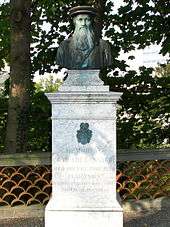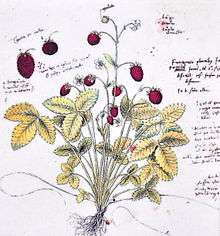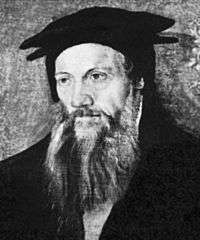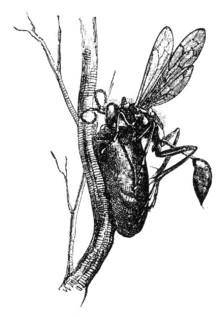Conrad Gessner
| Conrad Gessner | |
|---|---|
|
Portrait by Tobias Stimmer, c. 1564 | |
| Born |
26 March 1516 Zurich, Swiss Confederacy |
| Died |
13 December 1565 (aged 49) Zürich, Swiss Confederacy |
| Nationality | Swiss |
| Fields | Botany, zoology and bibliography |
| Alma mater | University of Strasbourg and University of Bourges |
| Author abbrev. (botany) | Gesner |
Conrad Gessner (also Konrad Gesner, Conrad Geßner, Conrad von Gesner, Conradus Gesnerus, Conrad Gesner; 26 March 1516 – 13 December 1565) was a Swiss naturalist and bibliographer. He was well known as a botanist, physician and classical linguist. His five-volume Historia animalium (1551–1558) is considered the beginning of modern zoology, and the flowering plant genus Gesneria and its family Gesneriaceae are named after him. A genus of moths is also named Gesneria after him. He is denoted by the author abbreviation Gesner when citing a botanical name.[1]
Life and education
Gesner was born on March 26, 1516 in Zürich, Switzerland, he was the son of Ursus Gessner, a Zürich furrier.[2] Gessner's father realized he was clever, and sent him to live with a great uncle, who grew and collected medicinal herbs for a living. Here the boy became familiar with many plants and their medicinal purposes which led to a lifelong interest in natural history.
Gessner first attended the Carolinum in Zürich, then he entered the Fraumünster seminary. There he studied Latin classics. In school, he impressed his teachers so much that a few of them helped sponsor him so he could further his education at universities such as Strassburg and Bourges (1532–1533). One even acted as a foster father to him after the death of his father at the Battle of Kappel (1531). After the death of his father he left Zürich and traveled to Strasbourg. Here he broadened his knowledge of ancient languages by studying Hebrew at the Strasbourg Academy. In 1535, religious unrest drove him back to Zürich, where he made an imprudent marriage. His friends again came to his aid and enabled him to study at Basel (1536).[3]
Throughout his life Gessner was interested in natural history, and collected specimens and descriptions of wildlife through travel and extensive correspondence with other friends and scholars. His approach to research consisted of four main components: observation, dissection, travel to distant lands, and accurate description. This rising observational approach was new to Renaissance scholars because people usually relied completely upon Classical writers for their research.[4] He died of the plague, the year after his ennoblement on December 13, 1565.
Career

In 1537 his sponsors obtained for him the professorship of Greek at the newly founded academy of Lausanne (then belonging to Bern). Here he had leisure to devote himself to scientific studies, especially botany.
After three years of teaching, Gessner was able to travel to the famous medical university of Montpellier, where he received his doctoral degree (1541) from Basel. He then settled down to practice medicine in Zürich, where he obtained the post of lecturer of Aristotelean physics at the Carolinum, the precursor of the University of Zürich.
After 1554 he became the city physician and it is there, apart from a few journeys to foreign countries, and annual summer botanical journeys in his native land, he passed the remainder of his life. He devoted himself to preparing works on many subjects of different sorts. Not content with such vast works, Gessner was also active as a linguist, putting forth in 1555 his book entitled Mithridates de differentis linguis, an account of about 130 known languages, with the Lord's Prayer in twenty-two languages.
Historiae animalium
Gesner's great zoological work, Historiae animalium, is a 4,500-page encyclopedia of animals that appeared in Zürich in 4 volumes between 1551 and 1558: quadrupeds, amphibians, birds, and fishes. A fifth folio on snakes was issued in 1587. A German translation of the first 4 volumes titled Thierbuch was published in Zürich in 1563. This book was considered to be the first modern zoological work. It built a bridge between ancient, medieval and modern science.

In Historiae animalium Gessner combines data from old sources, such as the Old Testament, Aristotle, Pliny, folklore, and medieval bestiaries, adding his own observations. He created a new, comprehensive description of the Animal Kingdom. This was the first attempt by anyone to describe many animals accurately. The book unlike many works of its time was illustrated with hand-colored woodcuts drawn from personal observations by Gessner and his colleagues.[4] Gessner was the first to describe the brown rat and the guinea pig in Europe.[5]
Even though he sought to distinguish observed facts from myths and popular errors and was known for his accurate depiction of many animals in Historiae animalium, he also included many fictional animals such as the Unicorn and the Basilisk, which he had only heard about from medieval bestiaries. But when Gessner doubted the accuracy of the opinions he relayed in his own writings, or the validity of the illustrations he included, he clearly said so. Besides any plant or animal's potential advantage to people, Gessner was interested in learning about them because of the moral lessons they could teach and the divine truths they might tell. He went into as much detail about some unreal animals as he did about real ones.[6] Later in 1556 he also combined real and fictional creatures in his edition of the works of Claudius Aelianus.
Historiae animalium includes sketches for many well-known animals, and some fictional ones, including unicorns and mermaids. He accomplished many of his works in a large part due to the web of acquaintances he established with leading naturalists throughout Europe, who included John Caius, English court physician to the Tudors and second founder of Gonville and Caius College, Cambridge. Not only did they send him their ideas, but also sent him plants, animals and gems. He returned the favor — and kept helpful specimens coming — by naming plants after correspondents and friends.[6]
Religion
There was extreme religious tension at the time Historiae animalium came out. Under Pope Paul IV it was felt that the religious convictions of an author contaminated all his writings.[7] Since Gessner was Protestant his works were included into the Roman Catholic Church's list of prohibited books. Even though religious tensions were high, Gesner maintained friendships on both sides of the Catholic-Protestant divide. In fact, Catholic booksellers in Venice protested the Inquisition's blanket ban on Gesner's books, and some of his work was eventually allowed after it had been "cleaned" of its doctrinal errors.[6]
Legacy

To his contemporaries he was best known as a botanist. Gessner wrote a similarly comprehensive survey to Historiae animalium about plant life, but his notes and about 1,500 wood engravings of plants and their important flowers and seeds were used by other authors for two centuries after his death.[3] Although his botanical manuscripts were not published (in Nuremberg, 1751–1771, 2 vols. folio) until long after his death, he himself issuing only the Enchiridion historiae plantarum (1541) and the Catalogus plantarum (1542) in four languages. In 1545 he published his remarkable Bibliotheca universalis (ed. by J. Simler, 1574), supposedly a catalogue (in Latin, Greek and Hebrew) of all writers who had ever lived, with the titles of their works, etc. A second part, Pandectarum sive partitionum universalium libri xxi, appeared in 1548; only nineteen books being then concluded. The last, a theological encyclopaedia, was published in 1549, but the last one, intended to include his medical work, was never finished.
Gessner in 1551 was the first to describe brown adipose tissue;[8] and in 1565 the first to document the pencil.
To non-scientific readers, Gessner is best known for his love of mountains (below the snow-line) and for his many excursions among them, undertaken partly as a botanist, but also for the sake of exercise and enjoyment of the beauties of nature. In 1541 he prefixed to his Libellus de lacte et operibus lactariis a letter addressed to his friend Jacob Vogel of Glarus on the wonders to be found among the mountains, declaring his love for them, and his firm resolve to climb at least one mountain every year, not only to collect flowers, but in order to exercise his body. In 1555 he issued his narrative (Descriptio Montis Fracti sive Montis Pilati) of his excursion to the Gnepfstein (1920 m), the lowest point in the Pilatus chain.
Despite his traveling ways and the job of maintaining his own gardens, Gesner probably spent most of his time inside his own library. He listed among his History of Animals sources more than 80 Greek authors and at least 175 Latin authors, as well as works by German, French, and Italian authors. He even attempted to establish a "universal library" of all books in existence. The project might sound strange to the modern mind, but Gessner invested tremendous energy in the project. He sniffed through remote libraries along with the collections of the Vatican Library and catalogs of printers and booksellers. By assembling this universal library of information, Gessner put together a database centuries before computers would ease such work. He cut relevant passages out of books, grouped the cuttings by general theme, subdivided the groups into more specific categories, and boxed them. He could then retrieve and arrange the cuttings as needed. In the words of science writer Anna Pavord, "He was a one-man search engine, a 16th-century Google with the added bonus of critical evaluation."
To his contemporaries, Gessner was known as "the Swiss Pliny." According to legend, when he knew his time was near, he asked to be taken to his library where he had spent so much of his life, to die among his favorite books. At the time of his death, Gesner had published 72 books, and written 18 more unpublished manuscripts. His work on plants was not published until centuries after his death.[6]
Gessner was posthumously partly responsible for Insectorum, sive, Minimorum animalium theatrum or Theatre of Insects, written jointly by him with Edward Wotton, Thomas Muffet and Thomas Penny.
In 1576 George Baker published a translation of the Evonymus of Conrad Gessner under the title of The Newe Jewell of Health, wherein is contained the most excellent Secretes of Physicke and Philosophie divided into fower bookes.
Memorials
- Gessner was featured on the 50 Swiss francs banknotes issued between 1978 and 1994.
- The Gessner herbal garden at the Old Botanical Garden, Zürich, is named after Conrad Gessner, and
- the cloister in the Carolinum, Zürich in the Grossmünster church, where Gessner is buried, also houses a herbal garden dedicated to Conrad Gessner.[9]
- On 16 March 2016 the State Museum in Zürich, in close collaboration with Zurich’s Central Library(Zentralbibliothek Zürich), dedicated a special exhibition to Gessner in celebration of the 500th anniversary of his birth. [10]
Works
.jpg)
- 1537 Greek-Latin Dictionary
- 1541 Enchiridion historiae plantarum
- 1542 Catalogus plantarum (1542)
- 1545 Bibliotheca universalis (ed. J. Simler 1574)
- 1545 Libellus de lacte et operibus lactariis
- 1548 Pandectarum sive partitionum universalium libri xxi
- 1551–1558 Historiae animalium
- 1551 Quadrupedes vivipares
- 1554 Quadrupedes ovipares
- 1555 Avium natura
- 1558 Piscium & aquatilium animantium natura
- 1552 Thesaurus Euonymi Philiatri
- 1553 Corpus Venetum de Balneis
- 1555 Mithridates de differentis linguis
- Historia Plantarum (ed. 1750)
- Der ... Theil des köstlichen und theuren Schatzes Euonymi Philiatri . Band 2 . Geßner, Zürich / Straub, S. Gallen 1583 Digital edition by the University and State Library Düsseldorf
See also
- Bloodhound and Rache for other pictures from Gessner's work
- Felix Platter, student and friend of Gessner.[11]
- Markus Krajewski: Paper Machines. About cards & catalogs, 1548-1929. MIT Press, Cambridge 2011, ISBN 978-0-262-01589-9. Credits Gessner with inventing the library card catalog.
References
- ↑ Brummitt, R.K.; C.E. Powell (1992). Authors of Plant Names. Royal Botanic Gardens, Kew. ISBN 1-84246-085-4.
- ↑ "Conrad Gesner". eNotes.com.
- 1 2 Pettitt, George A. "Conrad Gesner". Encyclopaedia Britannica.
- 1 2 North, Michael. "Conrad Gesner’s Historiae Animalium". US National Institute of Health
- ↑ Freye, H.A., and Thenius, E. (1968) Die Nagetiere. Grzimeks Tierleben. (B. Grzimek, ed.) Volume 11. Kindler, Zurich. pp. 204–211.
- 1 2 3 4 Scott, Michon. "Conrad Gesner". strangescience.net
- ↑ Schmitt, p. 46,
- ↑ Cannon, Barbara; Nedergaard, Jan (2008-08-21). "Developmental biology: Neither fat nor flesh". Nature. 454 (7207): 947–8. Bibcode:2008Natur.454..947C. doi:10.1038/454947a. PMID 18719573.
- ↑ "Kreuzgang Grossmünster – Oase der Besinnung" (in German). Hochbaudepartement Stadt Zürich. Retrieved 2014-11-16.
- ↑ "Conrad Gessner 1516-2016". Retrieved 8 October 2016.
- ↑ "Animal drawings collected by Felix Platter (1536–1614), part 2". Universiteit van Amsterdam. Retrieved 2014-11-03.
Sources
- Biographies were written by J. Hanhari (Winterthur, 1824) and J. Simler (Zürich, 1566).
- Pyle, C. M. (2000). "Conrad Gessner on the Spelling of his Name". Archives of Natural History. 27: 175–186. doi:10.3366/anh.2000.0002.
- Idem, "Conrad Gessner," in Encyclopedia of the Scientific Revolution from Copernicus to Newton, ed. Wilbur Applebaum, New York, Garland, 2000, 265–266.
- Idem, "Conrad Gessner" in Europe 1450–1789: Encyclopedia of the Early Modern World, Ed. Jonathan Dewald, Charles Scribner’s Sons, New York, 2004.
- McCarthy, Eugene M. "Conrad Gesner." http://www.macroevolution.net/conrad-gesner.html#.UpPSzMSX8ue, 2013.
 This article incorporates text from a publication now in the public domain: Chisholm, Hugh, ed. (1911). "article name needed". Encyclopædia Britannica (11th ed.). Cambridge University Press.
This article incorporates text from a publication now in the public domain: Chisholm, Hugh, ed. (1911). "article name needed". Encyclopædia Britannica (11th ed.). Cambridge University Press.
External links
 Media related to Conrad Gesner at Wikimedia Commons
Media related to Conrad Gesner at Wikimedia Commons Works written by or about Conrad Gesner at Wikisource
Works written by or about Conrad Gesner at Wikisource- Online version of Insectorvm Sive Minimorum Animalivm Theatrvm from GDZ
- Conrad Gesner's Thierbuch, Vogelbuch, Fischbuch, Schlangenbuch, De Scorpione – Reproductions of books.
- Urs B. Leu: Konrad Gessner in German, French and Italian in the online Historical Dictionary of Switzerland.
- "Gessner, Conrad (Konrad)". SIKART dictionary and database.
- The Natural History of Horses, with Memoir of Gesner by Charles Hamilton Smith
- Images from Icones Animalium... 1560.
- Online Galleries, History of Science Collections, University of Oklahoma Libraries High resolution images of works by and/or portraits of Conrad Gessner in .jpg and .tiff format.
- Thomas Muffet, Theatre of Insects (contains contributions by Conrad Gesner)
- Works by Conrad Gessner online at the Biodiversity Heritage Library.
- In 2012, Amsterdam University Library digitised the so-called Gessner albums (press release). Some of Gessner's drawings have been made available on Flickr: fish and other creatures of the sea, mammals.
- Gesner, Conrad (1565) De omni rerum fossilium genere, gemmis, lapidibus, metallis, et huiusmod - digital facsimile from the Linda Hall Library

